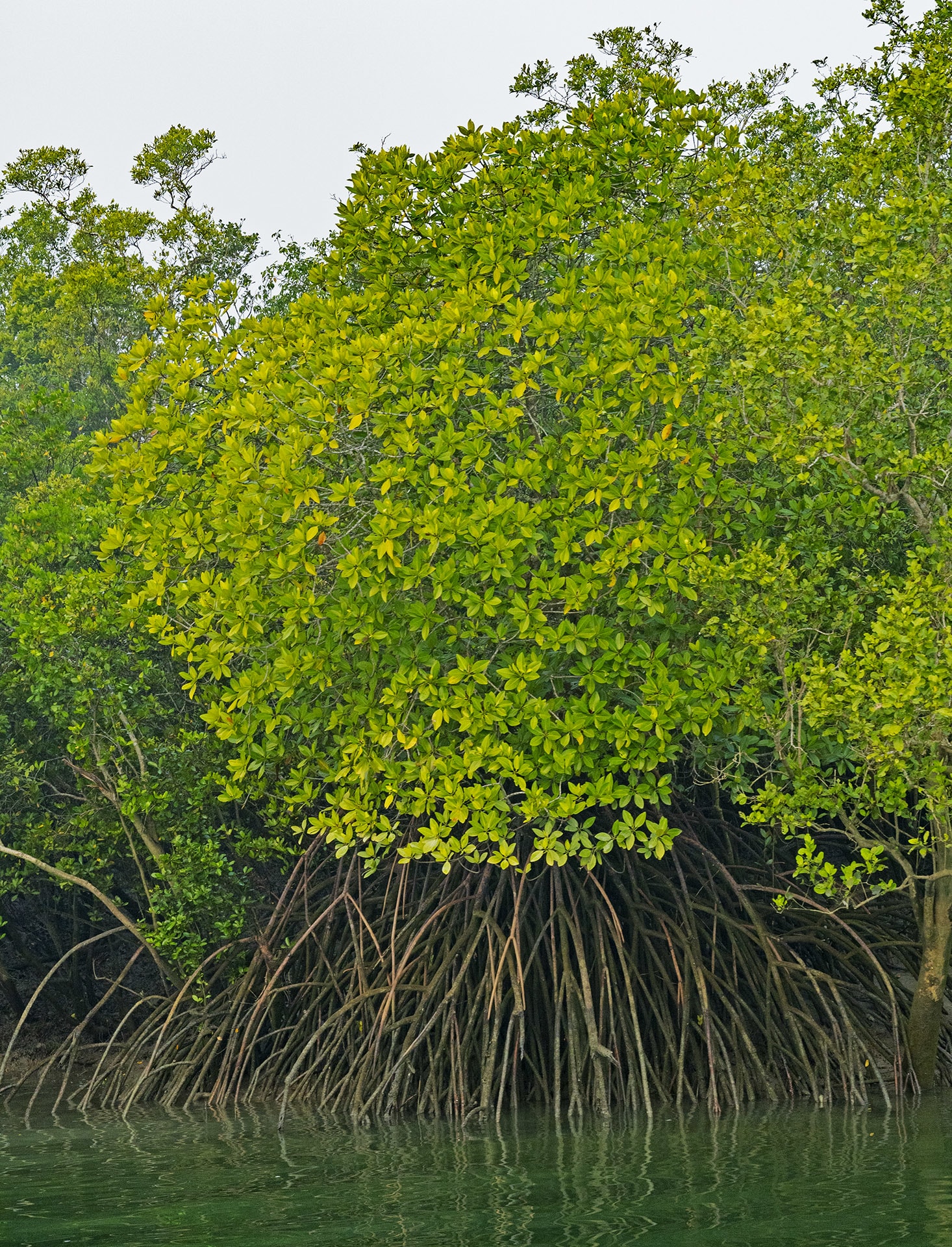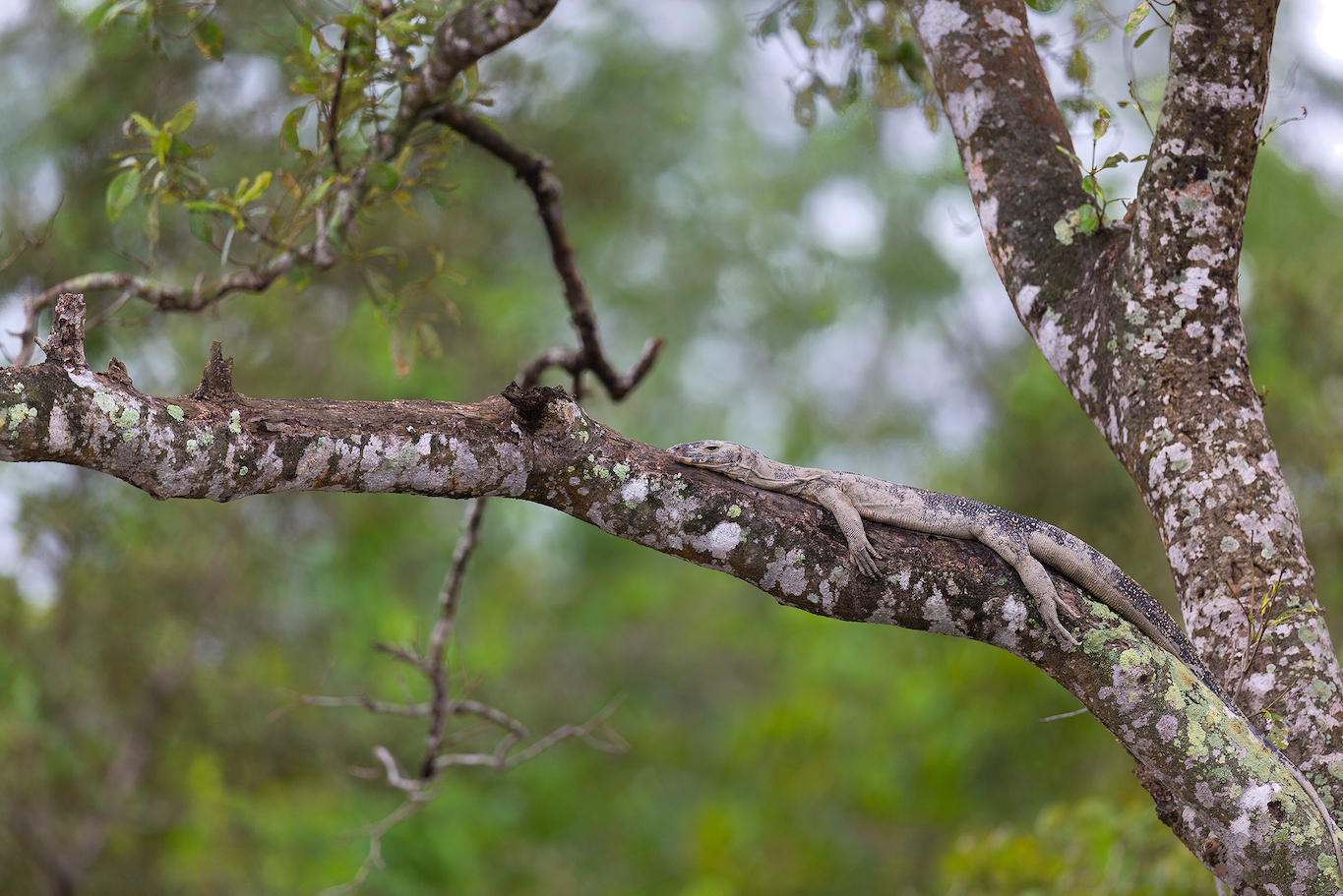It’s 3 pm and we are riding very, very, slowly through the Sundarbans’ labyrinth of sea-green channels, our eyes desperately trained on the dense mangrove forests for any sign of movement. “Look deep,” whispers Ramkrishna Mondal, my forest guide for the week. “And you might see a shiny, striped yellow coat. This mangrove is the tiger’s den.” I squint and stare at thickets of hental bushes. I can tell why the tiger is attracted to it — the short, squat, palm-like mangrove species, also called tiger palm, turns fiery yellow and red at the edges in winter, providing the tiger perfect camouflage. Its thick network of palm leaves builds a cover so dark, and dense, that it forms a formidable protective green barrier for anything that wants to hide behind it. I soon give up and let Mondal do the peering. But the moment I turn my attention away from looking for a tiger, I notice the forest transform. The coastal mangrove forest of the Sundarbans, along the Bay of Bengal, experiences high and low tides, twice a day. Over the last couple of hours, the tide has receded exposing sandy shores of islands that looked like floating forests only a few hours ago. Now, I am surrounded by wet, sparkling sandbars, and a mesmerising, woody world of tangled roots.

The garjan is a mangrove on stilts. Its long, umbrella-shaped stilt roots provide a broad, solid base, often wider than the tree-top, helping keep it stable in the face of harsh tides and loose sand. Photo: Dhritiman Mukherjee Goran or Ceriops decandra is supported by a network of roots that spreads horizontally below the surface. At irregular intervals they stick out and then loop back into the soil, resembling wobbly, mangled knees. These aerial “knee roots” help the entire underground root system breathe. Cover photo: Dhritiman Mukherjee
The active, underground network of roots has always been a forest’s best-kept secret. Researchers have spent years unearthing mysteries that lie merely inches beneath our feet. But in mangrove forests like the Sundarbans, the low tide lays a part of the hidden underground networks of a forest bare, giving us a rare glimpse into the fine architecture of roots that anchor mammoth estuarine jungles. Once I notice the tangle of roots, I am hooked. They take astonishing forms everywhere around me. Some stick out of the soft mud like spears ready to dart into the sky. Others look like serpents snaking around a moist, loose, mound of clay, holding on to it with all their might. A few peek out of water like an old man’s knobbly knees, and still others look like they are standing on lean, long, graceful flying buttresses. I am no longer looking for the tiger — a whole new world has just opened up.

Pneumatophores are specialised aerial root structures that grow perpendicular to the mangrove’s main horizontal root networks beneath the surface. Mangrove soil is oxygen-deficient and these adaptations work like snorkels that help underground networks breathe. These sharp roots are known to injure animals. Photo: Dhritiman Mukherjee (top). Arindam Bhattacharya (bottom)
Mangroves don’t get the credit and the attention they deserve. Born where two entirely opposite ecosystems — land and water — meet, mangroves are hardy survivors. They thrive in exceptionally difficult and stressful situations, constantly fighting off and protecting the islands against tidal waves, storms, and cyclones. They not only grow where no other tree would survive, but their firm, flexible roots sink and hold onto soft mounds of clay in constantly shifting waters, creating new land in the process. An entire world thrives within these forests. The Sundarbans, for instance, is one of the world’s largest mangrove forest (approximately 10,000 sq km or seven times the size of Delhi), interspersed with a stunning labyrinth of channels and creeks that make and remake a mosaic of islands along its banks. Its deep, impenetrable forests hide an astonishing diversity of species including the endangered Gangetic and Irrawady dolphins, the endemic northern river terrapin, and the Royal Bengal tiger.
Mondal quickly notices that my attention has shifted, and is now pointing at delicate, hay-coloured grass on the edges of the shores, swaying gently with the breeze. “That is dhani,” he says, “It is the first to grow on freshly deposited silt.” Once dhani (Oryza coarctata), and other kinds of grass, manage to steady some soil, it makes room for bigger, sturdier mangroves. Mangrove seeds often travel with floating tides and sink into these mounds. Keora (Sonneratia apetala) and khalsi (Aegiceras corniculatum) are some of the early species that colonise these loosely held together sandbars. Equipped with an incredible ability to survive in very saline waters, their sturdy roots trap flowing sediments, slowly and steadily creating land. Over the years, an island takes form, and as it grows larger and higher, only its edges submerge with every high tide. At the heart of the island, rarely touched by saline waters, species such as kankra (Bruguiera gymnorhiza), passur (Xylocarpus moluccensis), and sundari (Heritiera fomes) gain a stronghold. At the salty edges of this dune-shaped island water monitor lizards, mudskippers, and estuarine crocodiles thrive. At its heart, the Bengal tiger rules over a healthy prey base of spotted deer, wild boar, and rhesus macaque.

The mangrove forest supports an incredible biodiversity, which includes common species like the Bengal monitor lizard which is seen across a variety of habitats. Photo: Arindam Bhattacharya.
With great apprehension our boatman moves closer to the banks. The Sundarbans tiger is infamous for emerging from dense mangrove bushes without notice, and going straight for the kill, but for now the keora has our attention. Lined like soldiers along the banks, its emerald, waxy leaves glisten in the afternoon sun. A collared kingfisher resting on a branch, takes flight — its blue wings stand out against the emerald forest. But we are far more excited by what lies beneath our boat. Many keora trees along the shore lean into the river. “Keora fruits taste best when they are pickled,” says Mondal. Under the shade of keora, long, cone-shaped spears stick out of the clay, and seem to have little to do with the tree. But they are attached to a dense, lateral network of roots that spreads away from the tree trunk, just centimetres below the soil. Roots of terrestrial trees survive on oxygen in the mud, but mangroves grow on loose, saline, oxygen-starved clay. While a lateral network of “cable” roots gives the tree support, the aerial roots work like snorkels taking in oxygen through small circular pores called lenticels, and sustaining entire underground ecosystems beneath them.
While keora lines the banks of one creek, a graceful but sturdy army of garjan (Rhizophora apiculata) stands guarding the shores of another. During low tide, its stilt roots, arching away from the main trunk like flying buttresses, make for a formidable sight. Just before the tip of every root reaches the soil, it sprouts rootlets that steady the central root. These rootlets further split into multiple roots, sparking an endless process that builds a web of columns and arches so dense and sturdy that mighty tides struggle to dislodge a garjan. The garjan survives at the edges of the roughest shores of the Sundarbans. Beneath the surface of the water, its web gets mind-bogglingly complex. Several species, especially crustaceans, fungi, bacteria, amphibians, and fish, hide and thrive among its roots, away from predators. It’s the reason why mangrove forests are called nurseries.
Imagine coastal waves facing this formidable green wall of tightly packed roots, branches, and leaves. As a high tide enters the forest and gushes through these roots it is forced to slow down. While the roots above ground counter the speed of the waves, the roots under the surface grab the loose soil, preventing uprooting. When the tide recedes, all the sediments it carries are trapped by the mangroves, preventing large-scale soil erosion. Now imagine islands without these coast guards.
On 9 November, 2019, when the sun was about to set, the Sundarbans saw one of its worst cyclones in history. Bulbul destroyed the homes of millions, affecting the lives of over 30 lakh people across India and Bangladesh. Without the Sundarbans, experts believe, Bulbul could have travelled inwards and ravaged Kolkata. The mangrove forest absorbed the steam and rage of the cyclone, reducing its impact, and diverting it from the main islands. The islands without mangrove cover were hit more than the others. “I wouldn’t have been standing here if it weren’t for these mangroves,” says Mondal.

The Sundarbans is an ever-changing landscape shaped and reshaped by the incoming and outgoing tides, held together by a fortification of mangroves. Photo: Dhritiman Mukherjee
But though the mangroves battle fierce cyclones that come at them at more 130 kmph, they are not equipped to face the challenges that ruthless human development throws at them. In the last 200 years, more than half of the mangrove cover in the Indian Sundarbans has been destroyed to make room for farms, settlements, and other forms of development. Rising sea levels due to climate change is one of the biggest threats the mangroves face. Mangroves can survive as long as their respiratory roots are exposed to air. Rising sea levels submerge these roots and increase the salinity of waters that flow in with the tides. “Species that can adapt proliferate, others that struggle are slowly wiped out. An entire ecosystem is threatened by this shift,” says K Kathiseran, on the marine biology faculty at Annamalai University. A direct impact of this is already visible. The sundari mangrove, that the Sundarbans ironically draws its name from, is fast disappearing. It is listed as “Endangered” on the IUCN Red List.
“If this continues, by 2050, 80 per cent of the Sundarbans will be submerged under water,” says Kathiseran. And with it, this army of coast guards will fall, drowning an astonishing world.